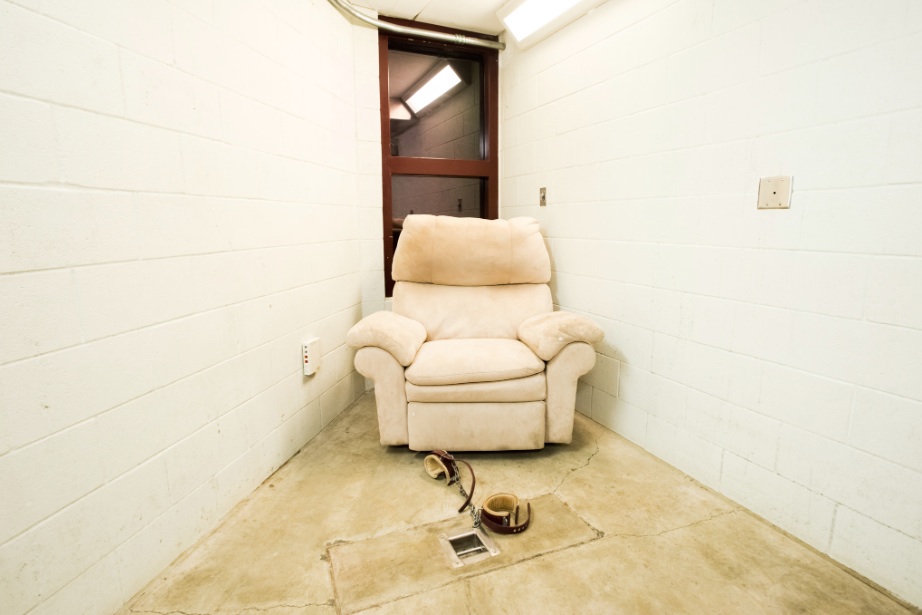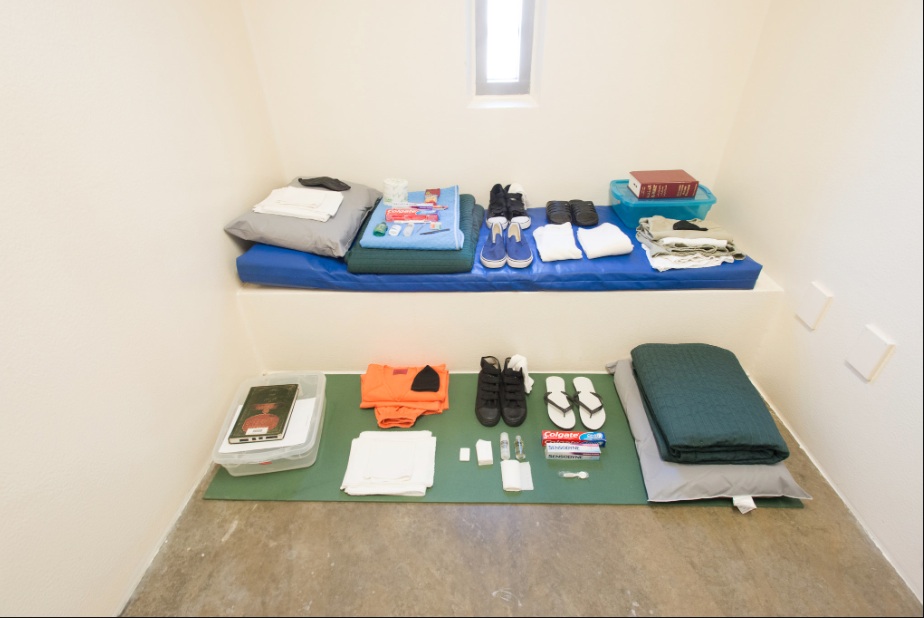I have a chair very much like this one in my living room. I sit in it when I am watching television or reading a novel or socializing with friends and family. It is really quite comfortable. Sometimes I even fall asleep in it. But there are differences. My living room is not made of cinder blocks or painted in a bland, institutional beige that matches the color of the chair and the floor and enhances the intensity of the harsh bright lights above; nor for that matter is my living room shaped as an acute triangle that doesn’t seem to be much more than 8 feet across at its base and it doesn’t have a one-way security mirror. And it should not go without mention that my legs are never shackled to the ground when I am sitting there.
The photograph is of the “Compliant Detainee Media Room” – that is both the caption for the photograph and the actual name of the room –at Guantanamo Bay, where one of the 149 prisoners being “housed” here can watch DVDs for an hour or two if he “follows the rules.” Prisons don’t have to be fully austere or inhumane institutions – and truth to tell it would be best if they were never neither of those things – but there is something oddly perverse about this scene as it underscores the extreme contradictions between comfort and constraint that govern our detention of prisoners who have never been formally charged with a crime or granted anything even approximating the due process of law. There are legal reasons we can get away with this, of course, since Guantanamo Bay is not governed by the U.S. Constitution, but such a technicality aside it surely violates the spirit of our founding documents.
“To comfort” is to give physical relief or sustenance, to provide support and serve as a source of strength, courage. It is fundamentally a social function. But nothing in this room is designed to do any of these things, or even anything close to them. It serves instead as a reminder of all that has been lost in the process of detention. The chair, which is designed to recline, is constrained by the feet that are shackled to the ground. The appearance of freedom is thus an illusion. All color has been removed from the world and with it something of the possibility to imagine difference. And finally, the very possibility of sociality has been effaced as there is only one chair, the only possibility for interaction with a polished mirror that displays the prisoner to himself (while knowing that others are watching his every move). The room, in short, is something of a torture chamber masquerading as a comfort station.
The contradiction between comfort and constraint is accented by a second photograph by the same photographer, captioned “Detainee Comfort Items.”
The photograph shows a single person detention cell. Everything is laid out in near perfect order, clothes and blankets clean and neatly folded, shoes shined, hygiene products new and unopened. The blue matt on the back wall is a mattress, and so it is pretty clear that the sleeping conditions are anything but comfortable—indeed, it is hard to imagine that the room is much more than six feet wide. But that turns out to be the least of it. And to get the point, ask yourself this question: In what world would these items—an orange jump suit, shoes, minimal hygiene products, a thin blanket and a pillow, a book—be considered comfort items?
What we have on display is a troglodyte world. One in which comfort has been recast as a teasing reminder of one’s condition of un-freedom. It is, in short, a world of constant and continual torture. And as we noted in a post at this blog many years ago, we wonder why they hate us?
Photo Credit: Debi Cornwall


Discussion